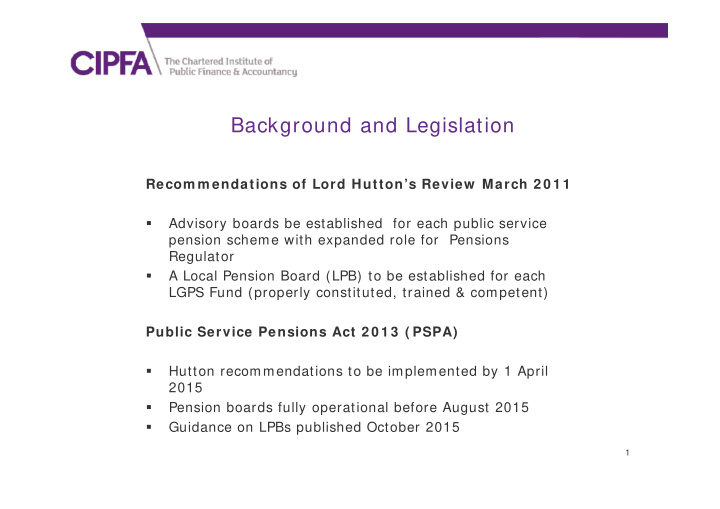



Background and Legislation Recom m endations of Lord Hutton’s Review March 2 0 1 1 Advisory boards be established for each public service pension scheme with expanded role for Pensions Regulator A Local Pension Board (LPB) to be established for each LGPS Fund (properly constituted, trained & competent) Public Service Pensions Act 2 0 1 3 ( PSPA) Hutton recommendations to be implemented by 1 April 2015 Pension boards fully operational before August 2015 Guidance on LPBs published October 2015 1
Impact of Legislation Under PSPA 2013 the administering authority becomes the scheme manager The full Council responsible for establishing pensions board and agreeing terms of reference The LPB is not a Committee of the Council (not established under the Local Government Acts) The LPB is not a separate legal entity TPR becomes a second regulator of the LGPS (joins CLG) 2
LOCAL PENSION BOARDS BOARD FUNCTI ONS Assist the Administering Authority (AA): To secure compliance with Regulations, other legislation and requirements of Pensions Regulator To ensure effective and efficient governance and administration of LGPS NB and to do so avoiding actual conflicts of interest 3
LOCAL PENSION BOARDS LPB “shall have the pow er to do anything w hich is calculated to facilitate, or is conducive to, the discharge of any of its functions” Knowledge and Understanding (K & U) are obligatory for Board members (minimum 15 scheme documents, minimum 73 aspects of pensions law) Training is a KEY requirement (using CIPFA knowledge & Skills and / or TPR On Line Toolkit) NB: most Board members are volunteers, who must have the capacity to fulfil the role. Issue of insurance for members of LPBs BUT Board is NOT a decision making body (assist Scheme Manager: support/ review / scrutinize/ recommend) 4
LOCAL PENSION BOARDS Mem bership and aspirations Equal number employer and member reps with voting powers: minimum of 4 in total Powys 2 + 2 An independent Chair, or a voting Chair? Powys Independent Open to Public? Powys YES Minimum 2 meetings a year Powys 3 + Observer status at Committee? Powys YES for LPB Chair Reciprocated at LPB? YES, (as an Open meeting) No conflicts of interest Protect Reputational Risk of Administering Authority Recommend improvements & justify own existence! Important relationships with Committee & LPB Secretary, and within the LPB Opportunities to network 5
LPBs Work Programme Topics that follow the annual / triennial cycles e.g. Fund Annual Report, Triennial Valuation Topics with external deadlines e.g. GMP reconciliation, Annual Benefit Statements Risk Register/ Scheme documents updates Priorities of The Pension Regulator & COP 14 and of the Scheme Advisory Board e.g. recorded & reported breaches, record keeping Priorities & business of the Pensions & Investment Committee Requirements under LPB’s Terms of Reference e.g. production of an annual report from LPB New legislation Ideas from Board members e.g. cash flow management and unauthorised payments NB there is a budget for the costs of the Board 6
LPBs: operations Do not make LPB agenda merely a re-run of Committee agenda i.e. Committee > > > > LPB Identify topics on which LPB can do a deep dive and then present summary recommendations to Committee, thus adding value and freeing up valuable Panel time i.e. LPB > > > > > Committee LPBs may seek assurances from a number of sources: The Pension Committee: via reports & minutes An Audit Committee and Internal Audit reports Any specially commissioned report Presentations by officers or external experts LPBs should be prepared to challenge assumptions and reports 7
Scheme Advisory Board (SAB) The purpose of the Scheme Advisory Board is to both reactive and proactive. It will seek to encourage best practice, increase transparency and coordinate technical and standards issues. Makes recommendations on scheme design (cost caps, accrual rate): may be passed to the DCLG or other bodies. It is increasing its liaison role with the Pensions Regulator. Guidance and standards may be formulated for local scheme managers and pension boards (e.g. training). Current survey of LPBs!! (responses from all parties: Board, Committee, Administering Authority) 8
The Pensions Regulator (TPR) Expanded role (Public Service Pensions Act 2013) now covers governance and administrative aspects of LGPS schemes but not funding and investment of funds: (but there is an expectation of LPB members being conversant with investment issues, especially investment processes) Code of Practice 14 now applies to LGPS Each Fund is reported and monitored as separate ‘scheme’ 3 levels of engagement: educate/ enable/ enforce Direct engagement with LPB Chairs and Board members Pow ers of Pensions Regulator include: Issue Improvement notices Replace Board members Impose civil penalties on Board members and corporate body for breaches of the law (recent example of a fine levied on a LGPS fund!) 9
The Pension Regulator’s Code of Practice 14 Governing your schem e Knowledge and understanding required by pension board members Conflicts of interest and representation Publishing information about schemes Managing risks Internal controls Adm inistration Scheme record-keeping Maintaining contributions Providing information to members Resolving issues Internal dispute resolution Reporting breaches of the law 10
The Pensions Regulator (con’t) TPR focus 2 0 1 6 and 2 0 1 7 Risk assessment and intelligence gathering Focus on: Basic compliance Top 3 risks: Record-keeping Internal controls Poor and ineffective communications “ We will use our educate/ enable/ enforce regulatory approach to help schemes comply and address key risks” Source: The Pensions Regulator 29 June 2016 11
LPB Recommendations for Powys Some examples Improvements to content of investment monitoring presentations Recommendations regarding compliance with TPR Code of Practice 14 Improvements to the Risk Register Expanded analysis of compliance with Myners Principles Enable the Committee to gain assurances from the LPB’s reviews of unauthorised payments and of cash flow management and liquidity 12
Recommend
More recommend